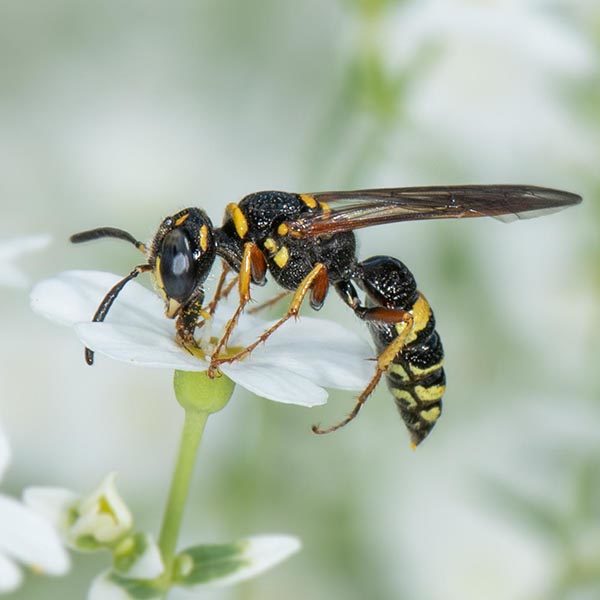
Listen to this Episode:
- From this webpage:
- Find the media player located under the episode picture.
- Click on the green triangle to listen to the audio for this episode.
- From your favorite podcast listening platform:
- Search for “Backyard Ecology.”
Show notes:
Like many people, I grew up with a healthy…. apprehension (ok, fear) of wasps. And, of course, I’ve seen all the memes on social media vilifying wasps and calling them names that I’m not going to repeat on this podcast.
But, those fears and concerns are mostly unfounded and misplaced. Wasps generally aren’t going to bother you, especially when they are on flowers, and they definitely aren’t the evil villains they are often portrayed as. Instead, they are a vital part of the ecosystem that helps control many different insect and arachnid populations, as well as, helps with the pollination of some plants.
In this episode of the Backyard Ecology podcast, we talk with Heather Holm. Heather is a pollinator conservationist and award-winning author. As of this recording, her book, Wasps: Their Biology, Diversity, and Role as Beneficial Insects and Pollinators of Native Plants, has just been published. Because wasps are such diverse organisms, her book focuses on the wasps that we are most likely to find visiting flowers.
Of course, I had to start our conversation by asking Heather the obvious question – “Why wasps?” Her answer was that as pollinator gardens become more popular, more people are beginning to notice wasps visiting the flowers. Her goal with this book is to help people better understand and appreciate those wasps, instead of being afraid of them.
In many ways, wasps are just like bees. In fact, bees evolved from wasps. Most adult wasps feed on nectar and other sugary substances like honeydew and tree sap. However, unlike bees which gather pollen to feed to their larvae, wasps hunt for prey to feed their larvae. The specific type of prey they hunt for depends on the species of wasp.
Wasps can be very specific with the prey they capture. For example, the cicada killer only hunts cicadas. In some cases, the cicada she captures may be 2-3 times her size! Another species of wasp, called the queen ant kidnapper ant, only eats queen ants that still have their wings and are coming back from their nuptial flights. There are also a number of wasp species that hunt spiders.
Just about every type of insect, plus spiders, is on the menu for some species of wasp and this has led to a wide diversity of wasp species. There are way more species of wasps than bees. And because their prey is so specific, you may find several different species of wasps nesting in close proximity to each other because their different diets mean that they aren’t competing with each other.
Like bees, most of our wasps are solitary which means that each female must create and provision her own nest(s). This doesn’t leave them much time, or desire, to defend their nests. Also like bees, wasps can be found nesting below ground, in standing dead trees, in logs, and in pithy or hollow stems. Some wasps even build nests made entirely of mud. Some of these mud structures can be very beautiful and delicate pots that look like they should be ceramic vessels in a dollhouse.
Despite their many similarities to bees, wasps are a group of animals that many people love to hate. However, they are rarely as bad as they are made out to be, especially when they are feeding on flowers. As Heather puts it, “the flower restaurant isn’t defended.” And in some ways, wasps can be easier to identify than bees. If you want to identify the wasps that you find on your flowers, Heather suggests taking lots of pictures including a top-down view, a sideview, and a head-on view. Using your flash can also be helpful for picking up details and reducing the blur if the wasp doesn’t sit perfectly still for you.
I encourage anyone who is interested in learning more about wasps, including how to identify them, to take a look at Heather’s book. And if you aren’t quite ready to venture into the world of wasps, then I still encourage you to take a look at Heather’s website. It is a treasure trove of free educational resources on pollinators, especially native bees. (In addition to her new wasp book, she has several other books on bees, pollinators, and native plants.)
Links:
- Wasps: Their Biology, Diversity, and Role as Beneficial Insects and Pollinators of Native Plants [hardcover] Heather N. Holm February, 2021 *
- Heather’s website
- Heather’s Facebook pages:
- Heather’s email: contact@pollinatorsnativeplants.com
- Backyard Ecology website
- My email: shannon@backyardecology.net
* Amazon links are affiliate links and I earn a small commission from qualifying Amazon purchases made the link. The commission is paid by Amazon and comes at no extra cost to you, but helps support the costs associated with hosting the Backyard Ecology blog, podcast, and website.
Episode image:
Bee wolf (Philanthus gibbosus) drinking nectar and serving as a pollinator
Photo credit: Heather Holm

Backyard Ecology: Exploring Nature in Your Backyard
Nature isn’t just “out there.” It’s all around us, including right outside our doors. Hi, my name is Shannon Trimboli, and I am the host of Backyard Ecology. I live in southcentral Kentucky and am a wildlife biologist, educator, author, beekeeper, and owner of a nursery specializing in plants for pollinators and wildlife conservation. I invite you to join me as we ignite our curiosity and natural wonder, explore our yards and communities, and improve our local pollinator and wildlife habitat. Learn more or subscribe to my email list at www.backyardecology.net.

Leave a Reply